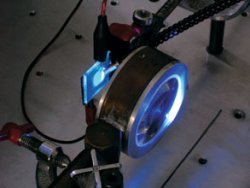
ic/uspBehind the lens, the device installed between two sheets of glass receives a light beam and produces an electrical pulseic/usp
The dream of computers and other electronic equipment endowed with circuits composed of molecules has gained a new contribution. Researchers at the Chemistry Supra-Molecular and Nanotechnology Laboratory of the Chemistry Institute (IQ) of the University of São Paulo (USP) announced in July the development of photoelectric chemical cells capable of functioning as logic gates, the devices responsible for the bits that carry digital information by way of the basic binary code used in computers and identified by the signals 1 and 0, equivalent to ‘yes’ and ‘no’. The new thing with this system is that these cells are built with molecules capable of responding to outside stimuli – such as electrical or optical impulses – generating electronic responses. “What we’re doing now is only a prototype that, in the future, could be used in a molecular computer. This is an advance, but we don’t as yet know what the ‘face’ of this computer would look like”, says he chemist Henrique Eisi Toma, a professor at USP’s Chemistry Institute.
Logic gates (LGs) are fundamental components of current digital electronics based on silicon technology. The combination of two entrance signals (they can be either 1 or 0) results in responses that describe the three basic types of logic gates: NOT, AND and OR, the others being (XOR, XNOR, INH, NOR etc.) obtained by a combination of the three. All existing processors and digital equipment on the market are operated by systems made up from combinations of these three basic LGs in accordance with well defined rules, receiving or generating signals comparable with binary language.
“The responses of each LG are used as entrances for other LGs, and when combined they generate logic circuits capable of carrying out simple operations.. They are interconnected to produce more complex devices and are present in equipment such as computers and cellular phones, among others”, explains professor Koiti Araki, who also participated in the new development.
The LGs currently used operate with the same principle as the first transistor developed in the decade of the 1940’s. With continued technological advance and the incessant miniaturizing of electronic components – that today have reached the scale of 50 nanometers (1 nanometer is equivalent to a one millionth part of a millimeter), this technology appears to have reached its limit, it being necessary to develop new devices.
“A possibility is the electronic molecule, and an example of the viability of this type of technology is the human brain. It is a humid superconductor based on molecules and molecular signals and one that uses a distinct language of the binary language of super computers built by man”, explains Toma. Thus, molecular computation inspires itself on the complex workings of the brain for the development of its components.
Colored film
The molecular device created by the Chemistry Institute team has dimensions of around 1 cm2, in the format of a ‘sandwich’ between two conductor sheets of glass. One of them has a nanostructured film of titanium dioxide (TiO2) sensitized by a molecular dye, made up of three ions (molecules/atoms that have lost or gained electrons) of ruthenium and molecules containing carbon, oxygen and nitrogen. The other conductor sheet has on its surface a film of nanoparticles of platinum placed upon a film of tin (IV) oxide (SnO2). When a beam of light is incident upon the ‘sandwich’, an electrical pulse is produced. An important particularity is that, depending upon the size of the light wave, the compound of ruthenium gains or loses electrons. This is the fundamental characteristic that transforms the photoelectric chemical cell into a logic gate of the XOR type (or exclusive) or INH (inhibitor) that generate the bits of information throughout an electronic circuit.
Given the unprecedented nature of the invention, the group has registered a patent for the device. “In principle, our LG could be miniaturized down to the nanometric scale, because its functioning depends only on the formation of a junction between the dye and the nanoparticles of titanium dioxide that have a dimension, on the tested device, of 20 nanometers in diameter. Thus a very large number could be built upon adequate substrates using photolithography (the printing of an electronic device circuit by way of light)”, says Araki.
It is not just today that various research groups in the world are attempting to use molecules as the raw material for the construction of electronic components, in the substitution or complementing the current solid devices mainly made from silicon. The first molecular logic gates came about during the decade of the 1980’s, but their manner of functioning was rudimentary and depended, at least during one of their stages, on the renovation or injection of the molecular compound solution. The logic gate developed by the Brazilian scientists is much more complex and functions in a regenerative manner, without the necessity of the renovation of the active substance, which is found immobilized on the device. The innovation has had a good reception in the international scientific community and was divulged through publications in the chemistry sector and that of new materials, such as the Angewandte Chemie, the magazine with the greatest impact in the chemistry area.
If only in the future the innovation could be used in the construction of molecular computers, today it already has a practical application. In the opinion of Henrique Toma, the molecular logic gate could be used as a device for energy conversion, transforming optical pulses into electrical signals. This is because the LG developed at USP is similar to a solar cell of the type DSSC (Dye Sensitized Solar Cells), and could be produced at low cost and therefore should, in the near future, become an option to the current silicon cells.
The Project
Development of super molecules, films and devices in supra-molecular nanotechnology
Modality
Thematic Project
Coordinator
Henrique Eisi Toma – USP
Investment
R$ 289,743.66 and US$ 138,441.15 (FAPESP)